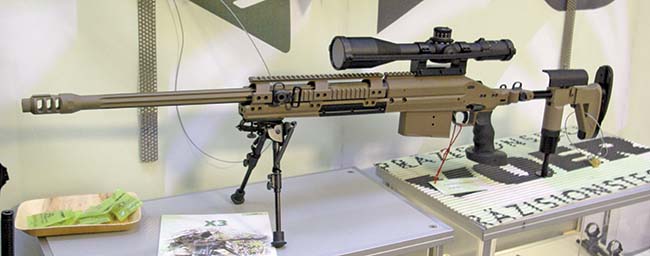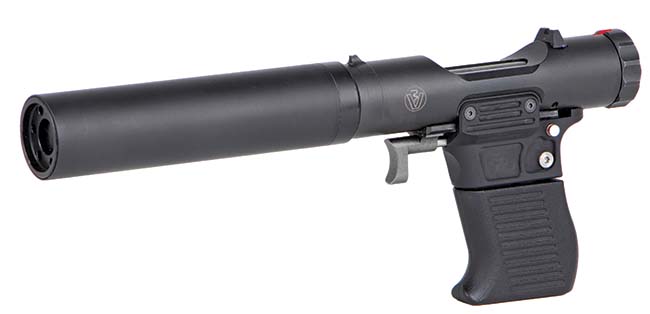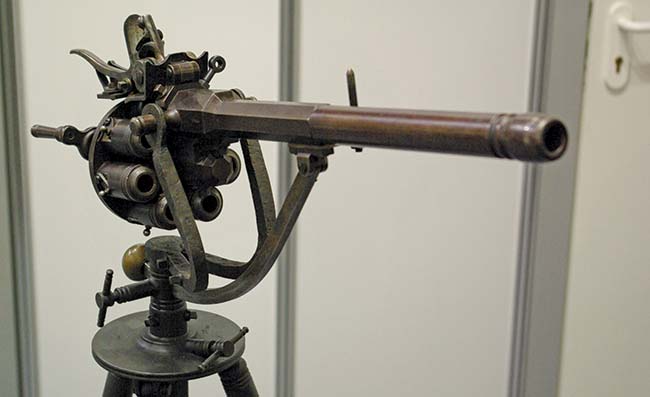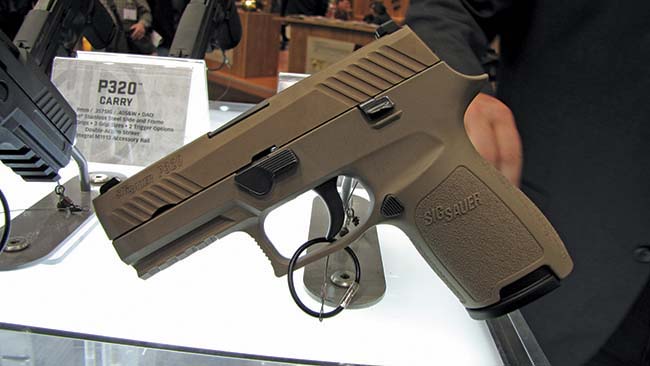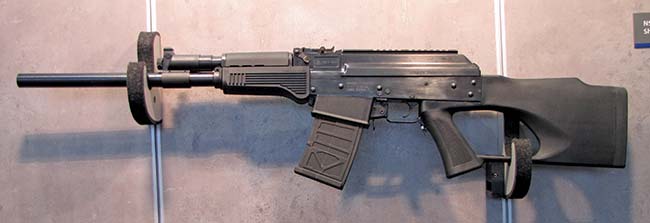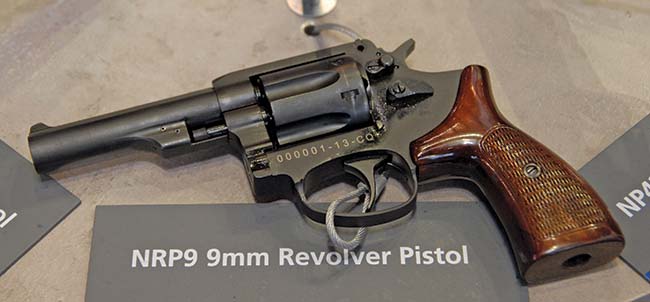ABOVE: Desert Tech of Salt Lake City, Utah, displayed their new bull-pup rifle, the dual-caliber (.308 and .223) modular Micro Dynamic Rifle, premiered at the SHOT Show. The MDR is one of the new wave of ambidextrous bull-pups. All it took was inventing a ‘direction-blind’ ejection system, allowing the rifle to be fired alternatively from both shoulders without changing the ejection direction. Amongst the early proponents were FN with their P90 (downward ejection) and F2000 (forward ejection), then Kel-Tec followed suit, but in reverse order (RFB – forward ejection, and recent RDB – downward). The downside of both earlier forward ejecting systems was that the case took a LONG way forward to eject. MDR proposes a fresh solution, something of a cross between sideward and forward ejection. The magic part is a simple lever, not unlike the pump-action shotgun lifter – but operating sideways. Or, for those more into old rifles, not unlike the Swiss StG 57 extractor. The bolt has only got the extractor, there’s no ejector as such. At the limit of the bolt travel, an L-shaped lever slides the brass to the right, depositing it into the receptacle of the ejection-cover mounted brass chute. The returning bolt pushes the brass forward at the same time when picking a fresh round from the magazine. The brass falls out obliquely to the right front of the rifle, clear of the face of a lefty shooter. And that’s it – a really clever idea.
Even though the IWA Outdoor Classic exposition held each March in Nuremberg, Germany, is traditionally mostly a hunting and sporting event, tactical users have also found some interesting things.
This year there was not just one, but two venues for the tactical aficionado. The IWA itself had a complete Hall 9 singled out for tactical displays – a new one, added this year, and one of the largest in the whole Nuremberg Fair complex. The other was a whole separate fair and conference devoted to military and law enforcement hardware and training preceding the IWA show – the Enforce Tac 2014.
The tactical trend, both in its professional and non-professional format (the latter, perhaps spending more for hardware than the real thing, as a whole – even though he spends his own, not the taxpayers’ money) is growing here in Europe, as it is in other parts of the world. Taking its cue from the U.S. SHOT Show, the IWA management tries to tap into that trend, expanding the law enforcement/military sector.
Starting this year, the Enforce Tac (also known – quite fittingly – as the ‘ET’) is again separated from the IWA – even though advertisements keep hammering the phrase ‘Enforce Tac by IWA’ at every possible opportunity. This connection was often interrupted in the past. At the beginning, since 2006, there was a two-day police training session organized by the Verein Polizeitrainer in Deutschland e.V. (PiD), accompanied by a modest (but growing with each year) exposition of the wares by the companies that sponsored the conference; but admittance was for conference guests only. Then, in 2012, the exhibition was moved from the conference venue to the IWA area, re-named the Enforce Tac show, and made to straddle both events, taking place on the second day of the conference and first of the show – with admittance to invited guests and journalists. The new venue was just a few steps outside the press office, between the office and the escalator leading down to the show – a perfect trap. After those two years, the 2014 ET returned to the previous schedule, but with a significant change. Now, the ET is no longer the Police Conference subsidiary: it’s the other way round. This year there were two parallel conferences: one on police force professional skills, with practical trainings, organized by PiD, which drew 550 participants from all over Europe (and then some), and the other on police equipment and armament, staged by the Deutschen Hochshule der Polizei of Münster (170 participants). The show moved once again, this time to Hall 10.1. This is one of the smaller halls, and it had to be partitioned in two (and still had lots of space) but that shows the growing potential of the ET, which was this year patroned by 50 companies including HK, FN, Rheinmetall and other industry’s heavyweights. If the growing trend continues, the annual Enforce Tac might with time replace the bi-annual GPEC, the police fair, in Leipzig – and then some day maybe Milipol of Paris as well, who knows?
The Enforce Tac is (yet) no match for the “tactical” hall of the IWA, nor in numbers of exhibitors, nor in coverage. Two days at the fringes do not equal the four days during the season’s prime industry gathering of the year. But it has certain advantages – e.g. the exhibitors can display hardware that they would not dare to show at the IWA unless deep behind the counter and by invitation only. The IWA still outlaws public display of real military weapons, particularly fully automatic ones. This might be a soft spot of the otherwise dynamically rising German show. They want to tap into the tactical trend, but still have to face protests from loden-clad gentlemen, outraged at the sight of those tan and black monstrosities at their fair, instead of as many cuckoo clocks or antler hanging boards. Waiting to see whose interest would prevail; let’s have a look at some of the stores.
ALR-338: A JAFAR on Steroids.
The AR is on the rise in the recent years, probably the half-centenary of the system has awakened interest. And it keeps rising. Each year we see AR-style direct impingement or piston-driven rifles firing bigger and more powerful rounds. Now that the AR chambered in .30-06 causes nothing more than a shrug, some have gone over the top, harnessing Stoner’s rifle to really powerful medium-caliber rounds, like the .338 Lapua Magnum. At the ET and then during the IWA, a German company displayed their ALR-338. The Schweinfurt-based company of Waffen Albert GmbH (a.k.a. Albert Arms) started as a firearms training business. Their headquarters contains one of the biggest ‘shooting cinemas’ in Germany, with a 55-yard indoor range fitted with a 26×16 ft. interactive target screen. There they started a firearms business and weapon repair shop. One of the shop’s attendants, a young Russian by the name of Vitaly Grauer, in his free time started to tinker with a large-caliber piston-driven AR. When he was finishing it, the boss decided to bankroll the prototype – as a matter of fact, hoping mainly for an advertisement value of the extreme endeavor. But as soon as the KSK (German Special Forces) trainees heard about it, the unfinished prototype was bought right away. Now, the ALR-338 (Automatic Long Range Rifle, .338 caliber) is series-manufactured, and for a while was a seriously-considered contender for the Bundeswehr medium-caliber sniper rifle, replacement of the G22 (the AI bolt-action rifle) until the military revealed that they’re looking for another bolt-action rifle. Nevertheless, the company has a full portfolio of orders for a rifle, capable (says DWJ gun magazine, Jan/2014) of putting 5 shots of .338 LM into a 69 mm circle at 300 m – in 9.87 seconds.

The ALR-338 is built on own-manufactured uppers and lowers, with a 650 mm long Lothar Walther match-barrel of 1:12 inch pitch (to be soon replaced by 1:10 inch pitch), fitted with M18x1 (same as Sako TRG-series) muzzle thread for a muzzle brake or suppressor attachment. The rifle is totally ambidextrous, with standard cocking handle replaced by two new, side-slot mounted ones. The bolt and bolt-carrier are of size and design appropriate to tame the powerhouse cartridge. The bolt has two rows of locking lugs, 16 in total. Even the extractor has two full-size lugs to stabilize the bolt-head. There’s a polymer accuracy wedge installed into the lower receiver, individually screw-adjustable from the outside to take out the play. Of course, as the ALR-338 is a product of the custom gunsmithing department, it can also be ordered in a mirror-image version for lefties, ejecting to the left.

PCO S.A.
The Warsaw-based Polish optronics company presented their wares at the joint Polish booth in Hall 9, with PSO Maskpol (means of ballistic and NBC protection), FB Lucznik-Radom (small arms manufacturer), ZM Tarnów S.A. (sniper rifles) and HPE Holsters (gun leather crafter). Amongst the PCO products the newest CKD-1 Szafir rifle sighting system was showcased. The Szafir (Sapphire) seems to be a new opening for the company, designed at the company’s own initiative, with an eye towards the Polish Soldier of the Future (ISW Tytan) – and now offered as the Polish Army’s new standard rifle sight for both legacy (Beryl) and objective (MSBS-5.56) individual rifle systems. The Szafir is comprised of two sights, a constant 4-power LDK-4 scope for precise shooting with an open MK-1 red-dot sight on top of it for CQB. The sight is still under development and its future will be cast by the results of the military testing.
X3 – Voere’s Back
The Austrian sniper rifle, Voere X3, is a further development of their modular 20-03 model, designed for tactical application. The 20-03 started a series of precision rifles that dusted-off the somewhat forgotten recently, once avant-garde trademark. Still remember that electric-primed ‘hunting’ rifle chambered for ‘caseless’ soft-point ammunition of the 1990s? Yes, that’s them, same Voere company. The first step towards X3 was the LBW hunting rifle, and its tactical sibling, the LBW-M, chambered in about everything starting with .222 Rem up to .375 H&H. Then came the .338 LM-chambered only LBW-M2, and here comes the X3, which is a notch bigger LBW-M2, shooting anything from .308 Win to .408 Chey-Tac. A bolt locking into a barrel extension enabled the aluminum receiver – but still depending on caliber and type of barrel (steel bull, steel fluted, carbon composite) the rifle weighs in at 7.6 to 8.6 kg (16.7 to 19 lbs.). Not Avant-guard enough for you? Then consider a 390 g (13.96 oz.) bolt, which is (save for the exchangeable bolt head in 4 caliber-group sizes) also made of aluminum in a .408 Chey-Tac rifle, mind you.
The X3 is a long-distance rifle, which you might guess by looking at the scope base. Instead of parallel with the bore it is 3 MOA convergent, so that firing a heavy bullet at a long distance you don’t have to move the reticle all the way up to find a cross-hair.

HK had displays at both ET and IWA. The ET booth was bursting at seams with LE/Mil weapons, while the IWA booth showcased the civilian offer. The main news at the LE/Mil booth was the all-new all-metal RIS forend for G36 in all lengths, made of aluminum with Grenade Launching Module anchor points. The forend had only two permanent 1913 rails, top and bottom, with now fashionable Keymod openings at the sides for temporary mounting of the shorter side rails – or accessories mounted directly into the keyholes. Other than that, the MP7A2 had a 1913 bottom rail instead of the folding foregrip, and there was the 5.56mm UTM-chambered pale blue Plastic Training MP7PT.
The HK booth in Hall 9 showcased the all-new product from the civilian line – the HK 243S. Finally, after 18 years of manufacturing, the G36 had spawned a civilian model worthy of a name, replacing the earlier ‘look-unlike’ nightmarishly disastrous SL8. The new HK243S is simply a semi-auto only G36, offered in black or Flat Dark Earth, and in two versions, or rather levels: the SAR (Semi Automatic Rifle) Sporter Basic Variant (semi-only equivalent of the basic military G36A1, fitted with the coveted KSK 1913 rail – MSRP in Germany 1,730 EUR) and TAR (Tactical Automatic Rifle) Sporter Professional (with KSK adjustable stock, low 1913 rail with integral BUIS and the all-new military Keymod RIS forend, with additional options of Norwegian-style bolt hold-open release within the trigger guard, MSRP Germany – 2,290 EUR). The third option was initially to be called the HK293S – being the same rifle in both configurations, fitted with a STANAG magazine adapter. The latter is finally to be called the same as the European version, but would be aimed squarely at the American market.
Brügger & Thomet VP-9: For Tactical Vets
Swiss suppressor maker Brügger & Thomet (B&T) showed a new product this year, a 9mm pistol called the VP-9, or Veterinary Pistol, 9mm. This weapon is a modernized copy of the British Welrod of World War II fame. The name is not some kind of a sophisticated camouflage, but its real intended use. Apparently, dispatching animal victims of road accidents rose in Switzerland to the level requiring a determined solution. The neo-Welrod would deal with the problem swiftly and without undue noise. Also, owing to the design of the suppressor, slowing the regular 124 grs bullet to subsonic speed, the ricochet threat is greatly reduced. The noise level is (according to the manufacturer) ‘not unlike slamming the car door’, or up to 129 dB with normal ammunition, and use of a subsonic round would reduce that by mere 4 dB. The pistol is 286 mm long and weighs in at 862 grams, the magazine holds 5 rounds, and the pistol is of course a repeating bolt-action weapon.
Transarms – Tactical Retro
German classical arms dealer Transarms has each year a small exhibition of their wares – from .45 Luger, to a Krieghoff Luger, to Red Nine Broomhandle or Colt 1902 Military. This year they truly outdid themselves by displaying the (replica) Puckle Defense machine gun – one of the earliest such ever, patented in England, on May 15, 1718. This is essentially a big crank-turned flintlock revolver with a single barrel and a 7-chambered cylinder, replenished by an assistant gunner. The inventor of that contraption, one James Puckle, even graced the patent drawing with a ready advertisement copy of his own pen: ‘Defending King George, your Country and Lawes, / is defending Your Selves and Protestant Cause’. To this end served the most frequently cited today idea of Puckle’s: using ‘ye olde rounde’ bullets against hostile Papists, and square-sectioned ones ‘to convince the Turks of the benefits of Christian civilization’. Somehow it proved not a commercial success, and as a newspaper of the era commented, the Puckle Gun ‘only wounded those who hold shares therein.’

Norinco ante portas
The new exhibitor this year, so far not in tactical Hall 9, is Norinco of China. They brought a nice selection of semi-only versions of the modern Chinese military rifles, like Type 81 (NR81 and NR81-2 folding stock model), or the bull-pups, like Type 88 (NR9TM) or Type 97 (NR97A as well as a compact NR97AS). New Chinese AR-15s were on display, as well – both ‘M16’ (NRCQ) and ‘M4’ (NRCQ-A) size. A new product, soon to trigger a visit of non-plussed Russians from Molot, was the NSS12 semiautomatic magazine shotgun, looking unnervingly alike to the Saiga-12. Another new product was the new Shanghai Police sidearm, the NRP9 revolver, mixing together in S&W-like layout an eclectic collection of ideas, like Ruger-like transfer bar firing mechanism with an additional manual safety.
American SIG-Sauer
After Swiss SIG fell, and German J.P. Sauer & Sohn reverted to hunting rifles, the U.S.-based SIGARMS soon overshadowed its roots, boldly breaking out from pistol ghetto into rifle territory under a new name of SIG-Sauer. Soon there were inevitable AR-15s and even 1911s coming down the chute. The MPX submachine gun series caused many an eye-brow to rise.
At the ET and IWA fairs SIG-Sauer displayed the new P320 pistol, a hammerless version of the P250, and a new rifle, modular SIG 556xi series. The selective fire variant has premiered at the ET, but semiautomatic version shown at IWA also drew crowds. This is a development of the older SIG 556, turning multi-caliber: the exchangeable lowers, barrels, bolts and magazines each rifle allow them to fire any of the three rounds – .223 Rem, .300 BLK or 7.62 x 39 Russian.






